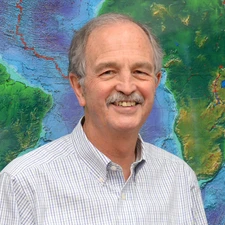Barry E. Parsons

The 2017 Augustus Love Medal is awarded to Barry E. Parsons for his contributions to marine geophysics, mantle convection and continental tectonics.
Barry Parsons has been behind major scientific breakthroughs in at least three areas: marine geophysics, mantle convection and continental tectonics. His physical models, results and methods have been used for decades by researchers from all over the world. His research is characterised by rigorous theoretical developments from first principles, attention to data and care to encapsulate results and ideas in clear and compact statements which can be used by others without difficulty. Parsons is responsible for a wealth of brilliant papers which marked their time and are still influential today. His work on ocean floor depth and heat flow provides the best discussion of plate models and the best methods to extract parameters such as plate thickness and ridge temperature. Rigorous data analysis and critical evaluation of theoretical models led to robust results that have not been improved upon since, despite countless attempts. He followed this with highly innovative models of plate behaviour, involving small-scale convection below the coldest part of the oceanic thermal boundary layer. Another set of remarkable studies dealt with the rates of oceanic plate creation and consumption and the area vs. age distribution of sea floor. Once again, simple theory and keen physical insight led to major advances in our understanding of plate tectonics. One of his papers on this topic, published in the Journal of Geophysical Research in 1982, is truly a classic and has spawned many others. He analysed in a supremely elegant and useful way the relationships between topography, gravity and temperature structure in convective bodies and followed this up with several studies of convection on Earth and Venus. This work laid the foundation for all subsequent work on relating mantle tomography to geophysical observables (gravity, topography) and inferences about structure of mantle flow. In the late eighties, he turned his attention to large-scale geodesy and tectonic deformation when these fields were still in their infancy. He first developed robust interpretation methodologies and efficient data acquisition techniques before tackling the key issue of determining small interseismic deformation rates in active tectonic areas. This culminated in scores of beautiful and innovative papers in which he and his co-authors went way beyond straight measurements of deformation rates and used their data to draw inferences on crustal rheology and to study tectonic activity at the lithospheric scale. He both trained and mentored a large number of scientists who have become very successful researchers and been the driving force behind the very successful long-running UK COMET geodetic and tectonic initiative which uses Earth observations to constrain dynamics.
